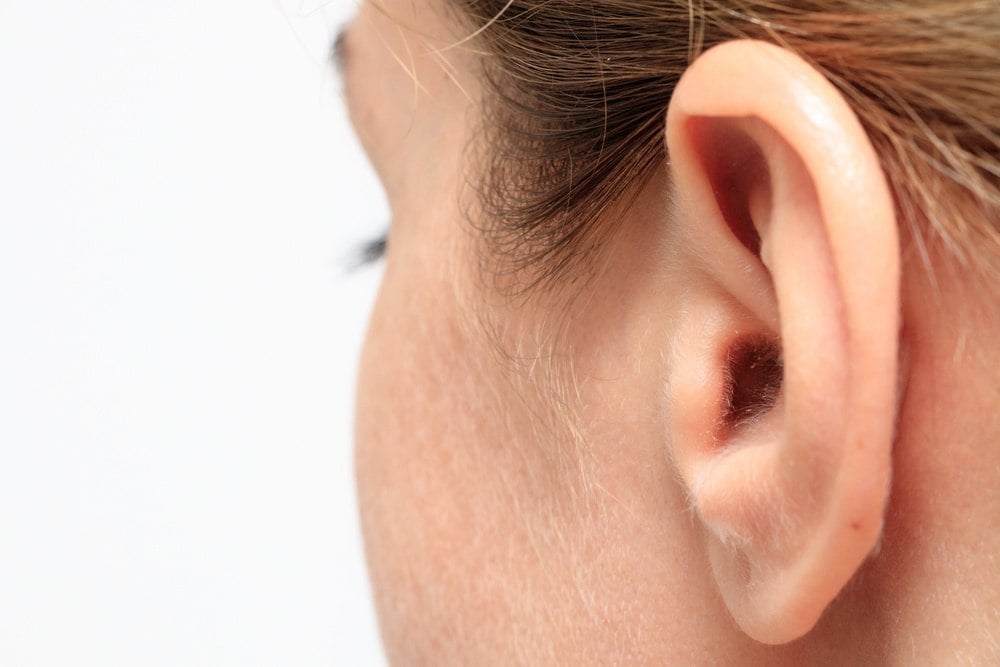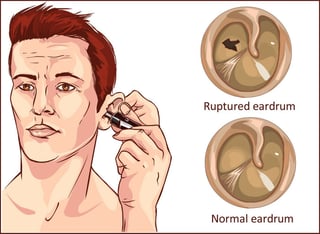Tympanic Membrane Perforation: Symptoms, Causes, and Treatment Options
March 15th, 2018 | 4 min. read
By Chuck Leider

Your tympanic membrane (TM) is an important component of your ear and your hearing. You most likely know it better as your eardrum. The tympanic membrane consists of several layers of tissue which are the:
-
Fibrous middle layer
-
Outer cutaneous layer
-
Mucous membrane layer on its deepest surface
A thick ring of cartilage holds the membrane in place. This cartilage is a flexible, tough type of tissue.
The function of your tympanic membrane, or your eardrum, is to help you hear. As sound waves enter into your ear, they hit your tympanic membrane making it vibrate and transmitting the vibrations further into your middle ear bones. Another function of your tympanic membrane is to guard your inner ear from developing an infection.
A tympanic membrane perforation (ruptured eardrum or a perforated eardrum) is a tear or hole in the thin tissue separating your eardrum from your ear canal.
Traumatic perforation of your TM may cause:
-
Vertigo
-
Bleeding
-
Pain
-
Hearing loss
Usually, a tympanic membrane perforation will heal itself without treatment within a few weeks. However, in some cases, it requires surgical repair for it to heal properly.
Tympanic Membrane Perforation Symptoms
The primary symptom of a TM perforation, or eardrum perforation, is pain. Some individuals experience severe pain. The intensity of the pain can increase or decrease and could remain steady all day long.
Some individuals don't experience any symptoms of a tympanic membrane perforation. Others feel like something just isn't right with their ear and experience general discomfort pushing them to see their doctor.
When blowing their nose, some individuals hear air coming from their ear. When you blow your nose forcefully, it causes air to move up into your middle ear, filling the space. In normal circumstances, this causes your eardrum to balloon outward. If you have a hole in your eardrum, however, air rushes out. Other people can even here the sound sometimes if it’s loud enough.
Other symptoms of a tympanic membrane perforation include:
-
Ear buzzing or noise
-
Sudden sharp pain in your ear
-
Sudden decrease of pain in your ear
-
Dizziness or facial weakness
-
Episodic ear infections
-
Partial or complete hearing loss in the affected ear
To determine treatment, it helps to know the cause of your tympanic membrane perforation.
Tympanic Membrane Perforation Causes
There are numerous causes of tympanic membrane perforation which include the following.
Pressure Changes
Certain activities may cause changes in pressure in your ear leading to a perforated eardrum. When this occurs, it’s called barotrauma and generally occurs when outside ear pressure is dramatically different from the inside ear pressure. The activities that could lead to barotrauma include:
-
Flying in an airplane
-
Shockwaves
-
Scuba diving
-
A forceful and direct impact on your ear
-
Driving at high altitudes
Infection
Ear infections commonly cause TM perforation, particularly in children. Fluids build up behind your eardrum when you have an ear infection. The fluid backup leads to a pressure that may cause your tympanic membrane to rupture or break.
Injury or Trauma
An injury may also cause an eardrum rupture. Any trauma to the side of your head or to your ear can lead to a rupture. Some common injuries or traumas known to cause a ruptured eardrum include:
include:
-
Being injured during sports
-
Getting hit in your ear
-
Getting into a car accident
-
Falling on your ear
Inserting any type of object into your ear like a pen, cotton swab or fingernail can also cause an eardrum rupture.
Damage to your ear or acoustic trauma from very loud noises can cause your eardrum to rupture. But, these aren't as common.
Tympanic Membrane Perforation Treatment Options
Just like protecting your ears from hearing loss is important, your best treatment against an eardrum perforation is prevention, if possible.
Prevention
To try and avoid a perforated or ruptured eardrum, follow these tips:
1. Get treated for a middle ear infection. Know middle ear infection symptoms and signs like:
-
Nasal congestion
-
Earache
-
Reduced hearing
-
Fever
Children with middle ear infection will likely pull on or rub their ears.
2. Don't put foreign objects in your ears. Don't try and dig out hardened or excess earwax with items like hairpins or cotton swabs as they can easily puncture or tear your eardrum. Make sure your children know not to do this as well and the damage they could incur if they did.
3. Protect your ears from excessive noise. Wear protective earmuffs or earplugs during recreational activities or in the workplace if loud noise is present to protect your ears from damage.
4. Protect your ears while on an airplane. If you can, try not to fly if you're experiencing an active allergy or cold that causes ear or nasal congestion. While landing or taking off, use things like yawning, chewing gum or pressure-equalizing earplugs to keep your ears clear. You can also use the Valsalva maneuver. This is where you gently blow out of your nose while you pinch your nostrils while closing your mouth.
Diagnosing a Tympanic Membrane Perforation
Your ENT doctor can use a few approaches to diagnose you of eardrum rupture, including:
-
Taking a fluid sample that's leaking from your ear to test for infection that could be the cause of your ruptured eardrum.
-
Performing an audiology exam, known as an audiometry exam. In this type of hearing test, your audiologist tests your eardrum capacity tympanometry and hearing range. When testing eardrum capacity tympanometry, your doctor will insert a tympanometer into your ear to see the pressure change response of your eardrum.
-
Performing an otoscope exam where they use a special type of device that has a light on it so they may look into your ear canal. An otoscope is a instrument your doctor uses to visually examine your eardrum and the outer ear passage. This instrument usually has a set of lenses and light.
Treatment of a Tympanic Membrane Perforation
Tympanic membrane perforations generally heal without treatment by themselves in a few months if there's no infection and the individual refrains from blowing their nose and stays away from activities that could exacerbate their condition like diving, swimming or taking medications other than what the doctor prescribes them. Your doctor may put in a short-term dam or patch to prevent infection if the tear is really big.
Keeping the Ear Dry
First and foremost the ear should be kept dry. In some cases, you may be asked to keep your ear dry by using a cotton ball covered with petroleum jelly to protect your eardrum from water when you shower or bathe. It is best not to go swimming with a perforated eardrum until it is completely healed.
Antibiotics
In some cases, a perforated TM can become infected and require antibiotics. Some types of ear drops could cause damage to your ear's nerve supply, therefore, your doctor will choose ear drops that don't come with this risk or they may prescribe you oral medication you take by mouth.
If you're experiencing discomfort, your doctor may recommend aspirin, acetaminophen or another type of over-the-counter medication for the pain.
Surgical Treatment
If your perforated eardrum doesn't heal on its own, you may require surgical treatment where your ENT surgeon repairs your eardrum using various techniques depending on the severity of the damage. Surgical treatment like this is called a tympanoplasty or myringoplasty and is typically successful at repairing a perforation and improving your hearing.
Call Houston ENT & Allergy Services
If you start experiencing pain or any of the symptoms of a tympanic membrane perforation above, call us here at Houston ENT & Allergy Services right away to get evaluated for a ruptured or perforated eardrum. Your inner and middle ears are made up of fragile components that are disease and injury sensitive. You need appropriate and prompt treatment to preserve your hearing.
